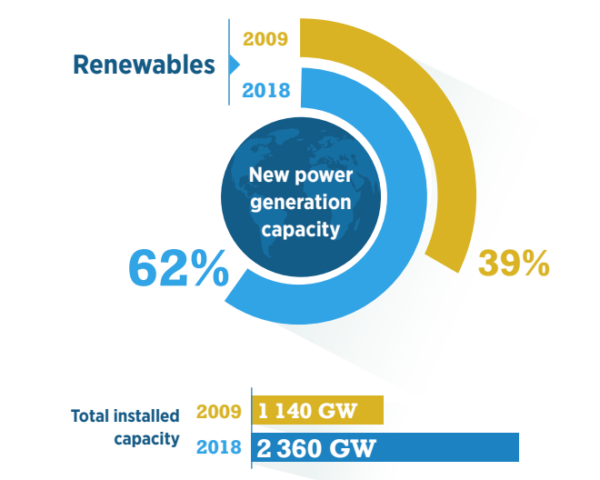At the start of what has been billed as a ‘decade of action’, the International Renewable Energy Agency (IRENA) has issued another call for a sustainable future. Stressing fossil fuel investment must be redirected, IRENA said annual renewable energy investment needs to more than double, from around $330 billion today to near $750 billion, to deploy renewable energy at the rate required.
The 10 Years: Progress to Action study published for IRENA’s 10th annual assembly charts recent advances and outlines the measures still needed to scale up renewables. The Abu Dhabi-based agency says the world needs to double the share of renewables in the global energy mix over the next decade to achieve energy transition objectives. Renewables must account for 57% of generation, said IRENA, renewable electricity must account for 29% of final energy consumption and fossil-fuel use must decline 20%.
Policy support and investment
“We have entered the decade of renewable energy action, a period in which the energy system will transform at unparalleled speed,” said IRENA director-general Francesco La Camera. “To ensure this happens we must urgently address the need for stronger enabling policies and a significant increase in investment over the next 10 years. Renewables hold the key to sustainable development and should be central to energy and economic planning all over the world.”
Much of the investment needed could be met by redirecting fossil fuel funds. IRENA calculates almost $10 trillion of non-renewables energy investment is planned to 2030, risking stranded assets and increasing the likelihood of exceeding the world’s sub-1.5 degrees Celsius carbon budget this decade. By comparison, the world invested $3 trillion in renewables in the last 10 years.

“We know it is possible, but we must all move faster,” La Camera said. Given falling technology costs, additional investments bring significant external savings, including minimizing the significant financial losses caused by climate change as a result of inaction. The potential savings could amount to $1.6-3.7 trillion per year by 2030, three to seven times higher than the investment cost of the energy transition, according to IRENA.
Renewables have already become the world’s main source of new power generation, as illustrated by the graph below. However, IRENA underlined renewables can also become the most competitive source of power by 2030. With 2.84 TW of solar generation capacity expected to have been installed in 2030, IRENA forecasts solar electricity prices of $34-40/MWh. Onshore wind costs are expected to be in the $30-40/MWh range with 2,015 GW of capacity installed worldwide at the end of the decade. The two energy sources would then account for a third of global power needs.

Already delivering electricity access to 150 million people, renewables can become a vital tool in closing the energy access gap, said IRENA. Data produced by the agency shows 60% of new electricity access can be met by renewables in the next decade with standalone generation systems and mini-grids providing the means for almost half that new access.
IRENA also repeated its claim the global energy transition could be an employment bonanza. By 2030, there could be 30 million renewable energy jobs, including 11.7 million solar opportunities, up from 4.4 million last year.
This content is protected by copyright and may not be reused. If you want to cooperate with us and would like to reuse some of our content, please contact: editors@pv-magazine.com.




1 comment
By submitting this form you agree to pv magazine using your data for the purposes of publishing your comment.
Your personal data will only be disclosed or otherwise transmitted to third parties for the purposes of spam filtering or if this is necessary for technical maintenance of the website. Any other transfer to third parties will not take place unless this is justified on the basis of applicable data protection regulations or if pv magazine is legally obliged to do so.
You may revoke this consent at any time with effect for the future, in which case your personal data will be deleted immediately. Otherwise, your data will be deleted if pv magazine has processed your request or the purpose of data storage is fulfilled.
Further information on data privacy can be found in our Data Protection Policy.